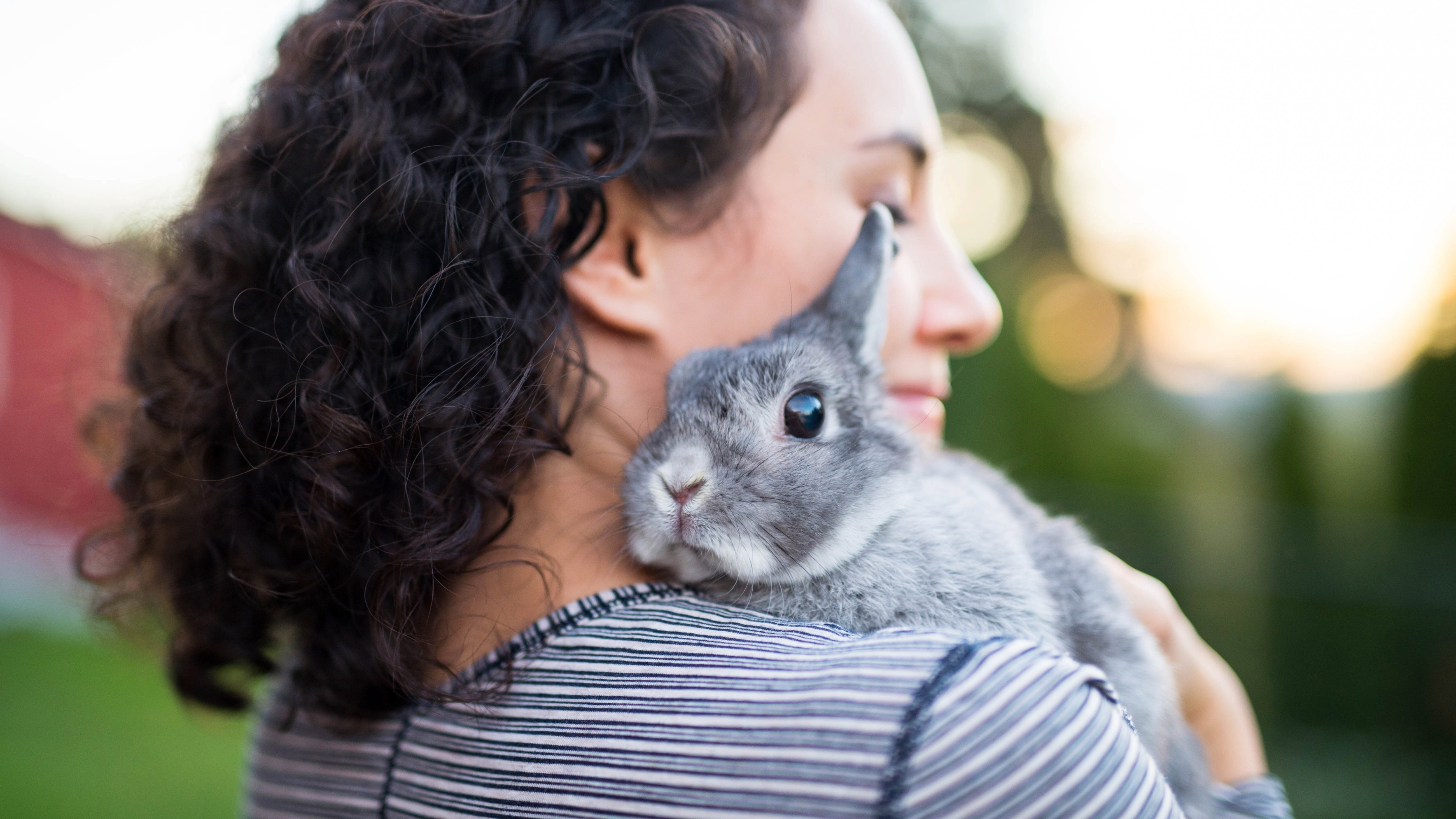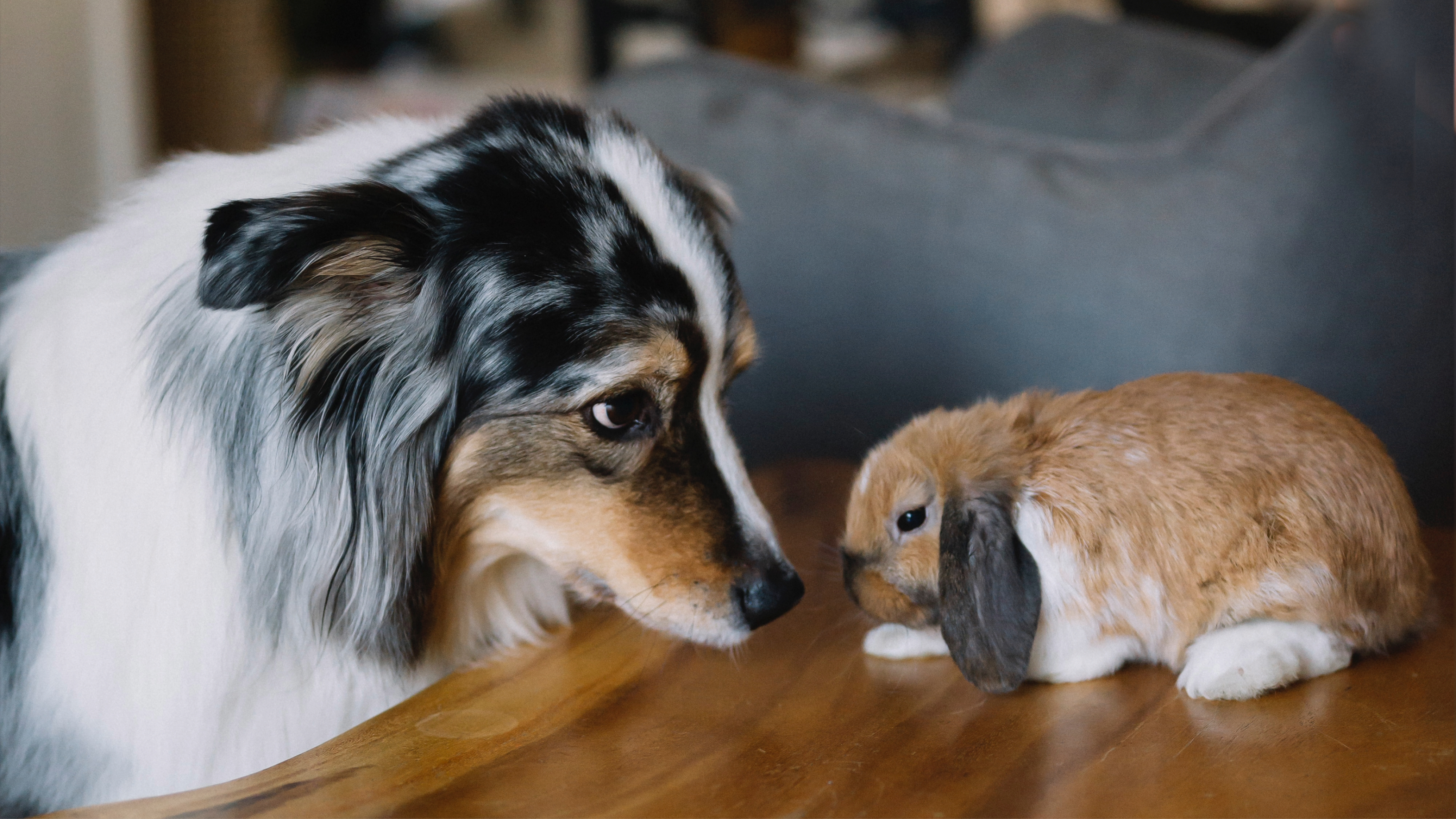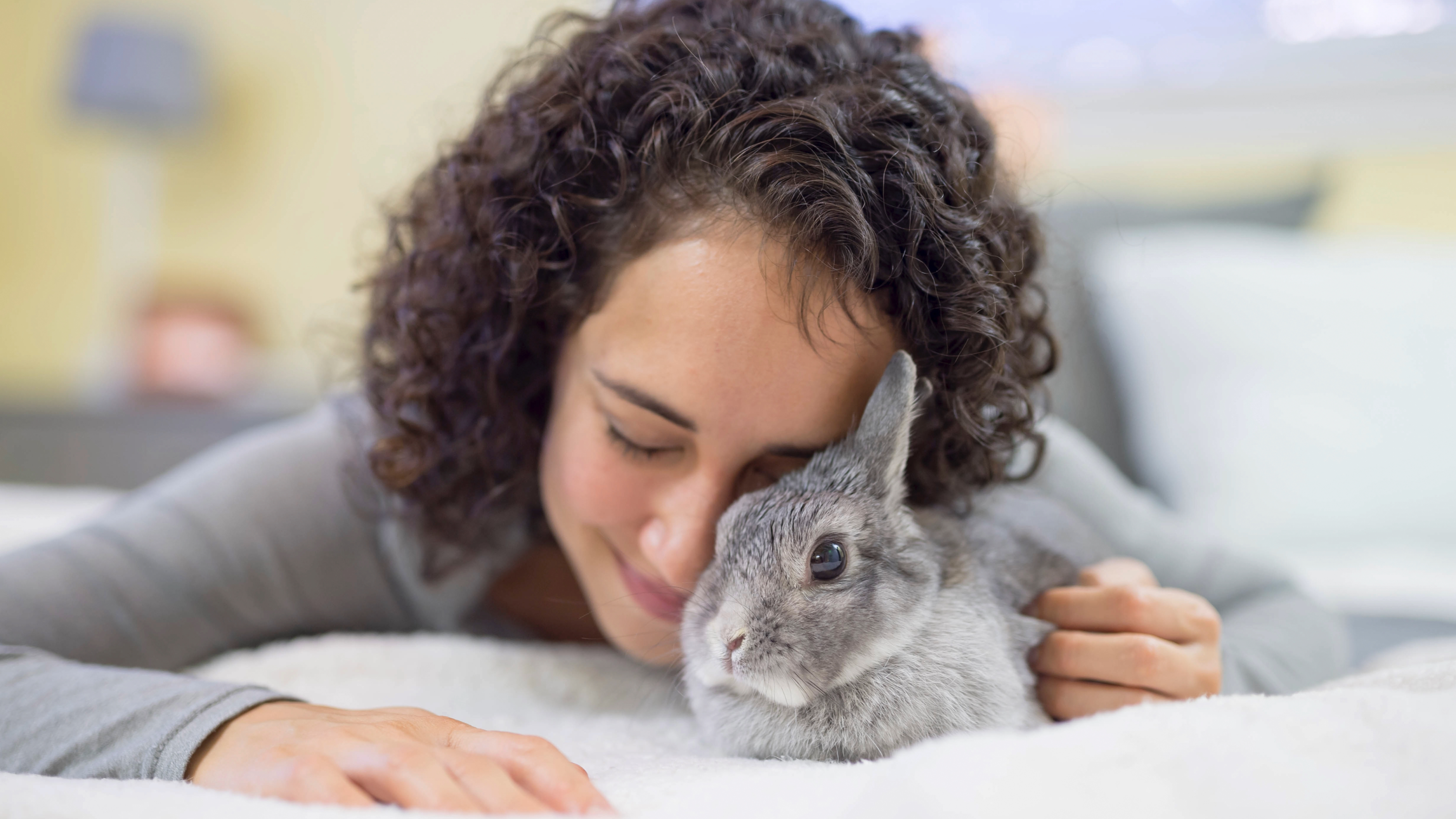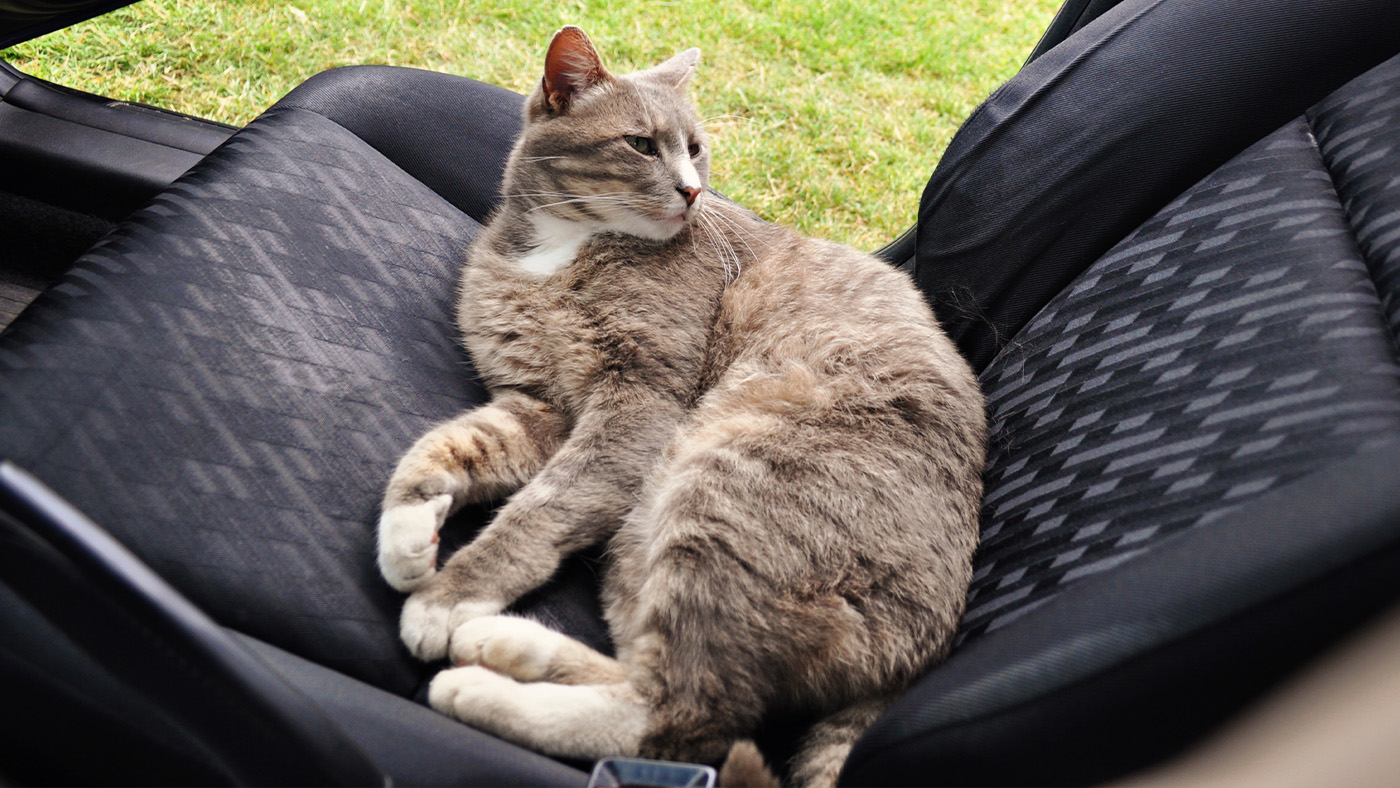32 things to consider before getting a rabbit
There are lots of things to consider before getting a rabbit — here's everything you need to know to help you decide if they're the right pet for you.

They may be super fluffy and adorable, but there are lots of things to consider before getting a rabbit. We often think of bunnies as being low-maintenance pets, but believe it or not, rabbits require more time and energy than you might think.
It’s easy to get caught up in thinking about the basics — investing in the best indoor rabbit hutch, the right food, and fun toys, for example, and forget about some of the more complex parts of being a bunny parent.
Rabbits are energetic creatures who require lots of physical and mental stimulation as well as plenty of human interaction. They do best when kept in pairs and because they require gentle handling and are typically not fond of being cuddled, they’re not always a good choice for homes with young children.
But while they do have particular needs you’ll want to be aware of, with the right love and care, rabbits can make wonderful companions. Here are some things to consider before welcoming a floppy-eared friend into your family…
32 things to consider before getting a rabbit
1. Rabbits live a long time

How long do rabbits live? A lot longer than you might think! While most of us understand that getting a cat or a dog is going to be a long-term commitment, we often underestimate just how long a bunny could be in our lives. Rabbits live for eight to 12 years on average, so it’s worth making sure you’re prepared for that before you adopt one.
2. They behave a lot like wild rabbits

Pet rabbits will behave exactly as they do in the wild. That means they’ll freeze or run for cover whenever they feel frightened, which is exactly what they’d do in the wild where they’re prey for other animals and are often hunted. Because of that, rabbits need a shelter they can retreat to so that they feel safe and secure.
3. Rabbits love being indoors

It used to be common for rabbits to be housed outdoors, but we’ve since discovered that our bunnies do best when housed indoors with their humans where they can become a true member of the family. How to care for a house rabbit consists of providing them with the right housing, diet, and enrichment as well as litter box training and bunny-proofing your house. But while it can take a bit of work initially, it’s well worth it.
PetsRadar Newsletter
Get the best advice, tips and top tech for your beloved Pets
4. They need a lot of space

How much space does a rabbit need? More than we often realize. At first glance, rabbits seem like quite small animals, and yet the amount of space they need to thrive is fairly substantial. Whether your floppy-eared friend is going to be living indoors or outdoors, they’ll need an enclosed area of at least 3m x 2m (10ft x 6.5ft) and it should be at least 1m in height (3ft).
5. Companionship is vital

Your floppy-eared friend will need some bunny to love because when it comes to the question of can rabbits live alone, the answer is that it’s not ideal. Rabbits are social creatures who do best when they have another rabbit to keep them company. In the wild, they always live in groups, so for the sake of their health and wellbeing, we recommend adopting them in pairs. The best pairing is a neutered male with a neutered female.
6. Active is their middle name

Rabbits are active and energetic little creatures who need plenty of space to hop about and play with the best rabbit toys. You can attach a run to their enclosure or use a large crate to give them safe access to exercise each day, or, if you’ve bunny-proofed the room they live in, you can give them complete freedom to roam. Whatever you decide, make sure they get at least four hours out of their enclosure each day.
7. They need lots of mental stimulation

Alongside regular physical exercise, rabbits also need a whole lot of mental stimulation each day. You’ll want to make sure you provide them with plenty of options to keep themselves entertained, such as chew toys, puzzle feeders, treat balls, and places where they can dig and forage.
8. You'll need to groom them

Yes, just like with dogs and cats, rabbit grooming is something you’ll need to do on a regular basis. While rabbits are fastidious about keeping themselves clean, brushing them each day isn’t just great for keeping their fur free of mats and tangles, it’s also a brilliant way to bond with them. Aside from brushing, be sure to trim their nails and check them for parasites.
9. There's a lot more to their diet than carrots

We know, rabbits and carrots go together like peanut butter and jelly, but there’s a whole lot more a bunny’s body needs to thrive. When it comes to what to feed a rabbit, their diet should mainly consist of grass (whether fresh or in the form of hay) as well as some herbs, leafy green vegetables, and a small amount of pellets. While it may sound boring to us, keeping your rabbit’s diet as close to what they would eat in the wild as you can will ensure they stay healthy.
10. Rabbits need to be house trained

When it comes to how to house train a rabbit, the most important thing is to invest in one of the best rabbit litter boxes and an appropriate litter. Once you’ve done that, start small with your training, confining your rabbit to just one area rather than the whole house (which can be overwhelming and increase the chance of accidents) and slowly work up to giving them more space.
11. Regular vet checks are a must

Just like cats and dogs, rabbits require regular vet checks to ensure they stay healthy. We recommend your bunny has a thorough examination once a year, although elderly rabbits or those with health issues will need to see the vet more often.
12. They don't like to be held

We know — rabbits are just so darn irresistible with their soft fur and cuddly good looks! But many rabbits don’t like to be picked up and that’s partly due to the fact that in the wild, a lot of animals see them as prey so being handled can make them freeze. Also, just like us humans, bunnies have different temperaments, so some prefer not to be held and petted or like to be petted on their own terms. However, with the right socialization when they’re young, some rabbits will absolutely enjoy being petted on the ground and others may even come in for a cuddle.
13. Rabbits love to chew

There are tons of facts about rabbits that might surprise you. For example, did you know that rabbit teeth are open-rooted and will continue to grow at a rate of 2-3mm each week for the rest of their life? It’s true! That’s why it’s so important to provide them with appropriate chewing outlets as this allows them to wear down their ever-growing chompers. Hay, dried apple sticks, bamboo, certain types of untreated wood, and willow are all safe chewing materials for your bunny.
14. Every bunny has their own personality

Rabbit personalities vary greatly from one bunny to the next, which when you think about it is exactly the same as us humans! Some rabbits will be shy and timid, others extroverted and outgoing. Some will want to sit near you, others will want to cuddle right into you and then there are the rabbits that prefer to keep to themselves. When adopting a rabbit, remember that they are unique creatures and each will have its own character.
15. Rabbits need to be socialized

While some rabbits are naturally gregarious, others are shy and may try to hide away. To avoid your bunny becoming scared of people, it’s important to get them used to interacting with humans from the moment you bring them home. Petting and handling them (being sure to support their hind legs) will ensure they settle into their new environment and become well-adjusted rabbits.
16. They can be fearful of other pets

Because they’re prey animals, rabbits are typically initially fearful of dogs and cats. However, if you introduce your bunny and other pets with care when your floppy-eared friend is young, they can go on to become good friends.
17. Rabbits aren't always ideal for children

When we think about the best first pets for children, rabbits often spring to mind — but more often than not, rabbits aren’t a great choice for children. Rabbits are fragile creatures and need very careful handling, they’re also not fond of excessive cuddling and many don’t like being picked up. If you have children and decide to get a pet rabbit, ensure their interactions are always supervised.
18. Bunnies can be expensive

For a small pet, rabbits sure can be expensive! Alongside the usual daily care, supplies, and annual check-ups, rabbits are also known for becoming unwell very quickly which means that by the time you get them to the vet, you may already be looking at a substantial bill to get them treated. Flat-faced breeds are also prone to expensive health conditions, so this is worth considering before you adopt one.
19. Gentle handling is very important

Rabbits are more delicate than you might think and they can also frighten easily, which is why when it comes to taking care of rabbits you want to handle them gently. When being picked up, it’s important to fully support their front and hind legs to avoid injuring their spine, and you never want to put a rabbit on its back. This is not a relaxing position for them and puts them into a state known as ‘tonic immobility’ which is the body’s freeze response. Being turned onto their back is highly stressful for rabbits so always keep them upright.
20. You’ll need to clean their habitat regularly

Rabbits need their enclosure thoroughly cleaned once or twice a week to keep their living space sanitary and odor-free. However, droppings and dirty litter need to be removed on a daily basis. When it comes to how to clean a rabbit cage, your once or twice-weekly deep clean should involve replenishing their bedding, sweeping their hutch, and cleaning down the entire thing with a pet-safe disinfectant.
21. They require a lot of attention

We have to confess, we had no idea until recently just how much attention rabbits require. It’s easy to think that because they’re small, they can be easily left to their own devices, but our floppy-eared friends need a minimum of four hours a day of human interaction. We recommend you let your bunny spend time with you whenever you’re home and awake — it doesn’t have to be exhausting either, they’ll be more than happy to sit next to you on the couch and watch Netflix at the end of a long, hard day!
22. Rabbits shed a lot

Have you ever found yourself asking the question ‘Why is my rabbit shedding so much?’ — while there are certainly health issues that can cause excessive shedding, rabbits naturally molt every three months and that means a whole lot of fluff on your floors. Grooming your rabbit regularly will help to limit the amount of fur you need to clean up but it’s worth speaking to your vet to get some grooming tips as bunnies have notoriously sensitive skin.
23. They can be destructive

If you’re planning on welcoming a rabbit into your family, you’ll definitely want to learn how to bunny-proof a room. As cute as they may be, rabbits are also very fond of chewing and digging, which means they have the potential to destroy your furniture, carpets, flooring, and anything else they can get their teeth and paws on. It’s also important to note that electric cables and cords look the same to our floppy-eared friends as the roots and twigs they’d nibble on in the wild, so be sure to secure these away using the appropriate tubing.
24. Rabbits are slow to trust

It tends to take rabbits quite a bit of time to form trusting bonds with their humans. It’s not because they’re not wonderfully friendly and loving pets, but remember that they are prey animals in the wild and so it’s a natural survival instinct for them to be wary of strangers. With time and patience, your bunny will slowly start to feel safe with you, which will make them want to come closer.
25. Dental problems are common

When it comes to common rabbit diseases, dental disease is right up there. This is commonly caused by an incorrect diet but some rabbits may also be born with dental issues. Chewing hay and wooden toys help rabbits to prevent their teeth from overgrowing, however, some rabbits have teeth that are out of alignment which means they aren’t able to grind down properly and the teeth continue to grow. It’s important to take your rabbit to the vet for regular tooth trimming if they have a dental problem that prevents them from being able to do this themselves.
26. Rabbits can get uterine cancer

Uterine cancer is one of the most common forms of cancer in rabbits and affects up to 80% of female rabbits over the age of three who are still capable of reproducing and once the disease takes hold, most rabbits don’t recover. The good news is that this form of cancer is completely preventable if a female rabbit is spayed, which is why we recommend doing this as soon as it’s safe to do so — most vets will carry out this procedure once a female bunny is between four and six months of age.
27. A rabbits poop will tell you a lot about their health

If you own a rabbit, you don’t need us to tell you that they poop a lot — up to 200 times a day to be exact! Rabbits stay healthy through the constant movement of their digestive system and healthy poo tends to resemble a cocoa puff. Keeping an eye on your rabbit's poop and watching for anything outside of the norm will help alert you to any potential health issues early on.
28. Bunnies are bigger than you think

We often think of rabbits as being fairly small pets and they’re certainly categorized that way, but in reality, rabbits routinely reach weights of six to eight pounds with the biggest breeds tipping the scales at 15 pounds or more. That’s bigger than many cat and dog breeds!
29. Their thump is really loud

Do you like the quiet life? If so, you might think it makes sense to get a rabbit. And on the one hand that’s true. Rabbits don’t meow like cats or bark like dogs, but believe it or not, when a rabbit is scared or angry, they’ll thump, which sounds a bit like a heavy textbook has just fallen off your bookshelf. While thumping isn’t particularly common amongst house rabbits, it does still happen from time to time and, once they get going, rabbits will tend to thump for several minutes.
30. Rabbits can get sick very quickly

Rabbits have evolved to hide their weaknesses, which means they’re very clever at covering up when they’re unwell. This can make it very difficult to know that they’re sick until they start to present with more extreme symptoms. Pay close attention to any changes in eating and grooming habits as well as fluctuating energy levels and drooling. If you notice anything concerning, be sure to get them checked over by a vet as soon as possible.
31. You can learn a lot from their body language

Ever wondered what your rabbit’s body language is trying to tell you? When rabbits are happy, they tend to do what’s known as a binky — where they run, jump, and do a half twist. Although it’s most common to see younger, energetic bunnies do this, older bunnies will do binkies when they’re happy, too. They also have their own version of the zoomies, where they’ll run around in circles. In contrast, bunnies that are worried or stressed tend to sit in a crouched position with their ears flat and their muscles tense. Understanding rabbit body language can give you valuable information about your bunny’s physical and mental wellbeing.
32. Rabbits multiply quickly

We almost fell off our chairs when we learned that a single unspayed female rabbit could give birth to as many as 30 babies in one breeding season. Rabbits can become pregnant again within hours of giving birth (yes, we know, it sounds exhausting) so be sure to get your floppy-eared friend spayed to avoid having to deal with a ton of bunny babies!
Enjoyed this? You might also want to learn about International Rabbit Day and how to keep a rabbit warm in the winter.

Kathryn is a freelance writer who has been a member of the PetsRadar family since it launched in 2020. Highly experienced in her field, she's driven by a desire to provide pet parents with accurate, timely, and informative content that enables them to provide their fur friends with everything they need to thrive. Kathryn works closely with vets and trainers to ensure all articles offer the most up-to-date information across a range of pet-related fields, from insights into health and behavior issues to tips on products and training. When she’s not busy crafting the perfect sentence for her features, buying guides and news pieces, she can be found hanging out with her family (which includes one super sassy cat), drinking copious amounts of Jasmine tea and reading all the books.
